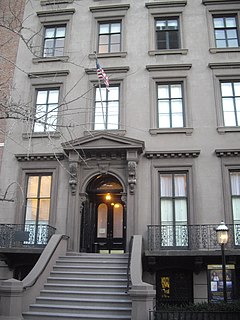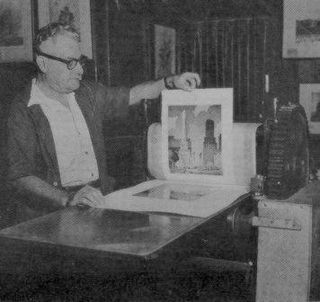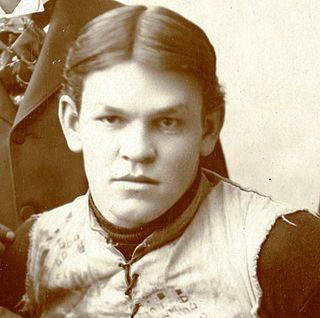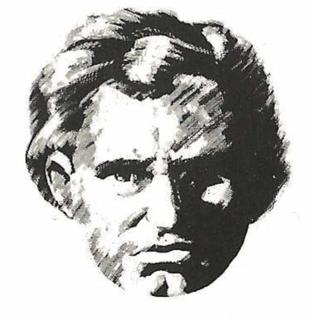Ray C. Strang (1893 in Sandoval, Illinois, United States – 1957) was an American Western artist and illustrator. He was educated in Centralia, Illinois, and attended the Art Institute of Chicago, Art Students League of New York and New York School of Fine and Applied Arts. Strang's education was interrupted by The Great War, in which he was wounded in the Forest of Argonne.[ citation needed ] During World War II, he took part in the Consair art colony at the Tucson division of the Consolidated Aircraft corporation. [1]

Sandoval is a village in Marion County, Illinois, United States. The population was 1,434 at the 2000 census.

Centralia is a city in Clinton, Jefferson, Marion, and Washington counties in the U.S. state of Illinois. The population was 13,032 as of the 2010 census, down from 14,136 in 2000.

The Art Institute of Chicago, founded in 1879 and located in Chicago's Grant Park, is one of the oldest and largest art museums in the United States. Recognized for its curatorial efforts and popularity among visitors, the museum hosts approximately 1.5 million guests annually. Its collection, stewarded by 11 curatorial departments, is encyclopedic, and includes iconic works such as Georges Seurat's A Sunday on La Grande Jatte, Pablo Picasso's The Old Guitarist, Edward Hopper's Nighthawks, and Grant Wood's American Gothic. Its permanent collection of nearly 300,000 works of art is augmented by more than 30 special exhibitions mounted yearly that illuminate aspects of the collection and present cutting-edge curatorial and scientific research.
For 17 years Strang was a successful illustrator in New York for such magazines as The Saturday Evening Post , The American Magazine , [2] Ladies' Home Journal , Country Home Country Gentleman and Harper's . He created covers for Dodd, Mead and Company and other publishers.[ citation needed ] He then went West to become a well-known painter who specialized in nostalgic depictions of the Wild West and the prairie life. His paintings hung in many galleries, including Grand Central palace in New York, Bender Gallery in Kansas City, Alden Gallery in St. Louis, [2] the Chicago Art Institute and the New York Art Center. His most famous painting was a work called "Slow Poke", of which there were many reproductions printed. [3]

The Saturday Evening Post is an American magazine, currently published six times a year. It was published weekly under this title from 1897 until 1963, then every two weeks until 1969. From the 1920s to the 1960s, it was one of the most widely circulated and influential magazines for the American middle class, with fiction, non-fiction, cartoons and features that reached millions of homes every week. The magazine declined in readership through the 1960s, and in 1969 The Saturday Evening Post folded for two years before being revived as a quarterly publication with an emphasis on medical articles in 1971.

The American Magazine was a periodical publication founded in June 1906, a continuation of failed publications purchased a few years earlier from publishing mogul Miriam Leslie. It succeeded Frank Leslie's Popular Monthly (1876–1904), Leslie's Monthly Magazine (1904–1905), Leslie's Magazine (1905) and the American Illustrated Magazine (1905–1906). The magazine was published through August 1956.

Ladies' Home Journal is an American magazine published by the Meredith Corporation. It was first published on February 16, 1883, and eventually became one of the leading women's magazines of the 20th century in the United States. From 1891 it was published in Philadelphia by the Curtis Publishing Company. In 1903, it was the first American magazine to reach one million subscribers.
Strang was an active member of the Fine Arts Association, Palette and Brush club and belonged to the Salmagundi Club of New York City. He had a ranch near Safford Peak in the Picture Rocks section of the Tucson Mountains, where he died in 1957. Ray Strang did many paintings including "Playmates" which is a canvas painting of two foals.

The Salmagundi Club, sometimes referred to as the Salmagundi Art Club, is a fine arts center located in New York City. It was founded in 1871 in the Greenwich Village section of Manhattan, New York City. Since 1917, it has been located at 47 Fifth Avenue. As of 2014, its membership roster totals roughly 900 members.

Picture Rocks is a census-designated place (CDP) in Pima County, Arizona, United States. The population was 8,139 at the 2000 census.

The Tucson Mountains are a minor mountain range west of Tucson, Arizona. The Tucson Mountains, including Wasson Peak, are one of four notable mountain ranges surrounding the Tucson Basin. The Santa Catalina Mountains lie to the northeast, the Rincon Mountains are to the east of Tucson, and the Santa Rita Mountains lie to the south. Additionally the Sierrita Mountains lie due south, the Roskruge Mountains lie to the west across Avra Valley, the Silver Bell Mountains lie to the northwest, and the Tortolita Mountains lie to the north across the Santa Cruz Valley.
He married and had a son. [2]





